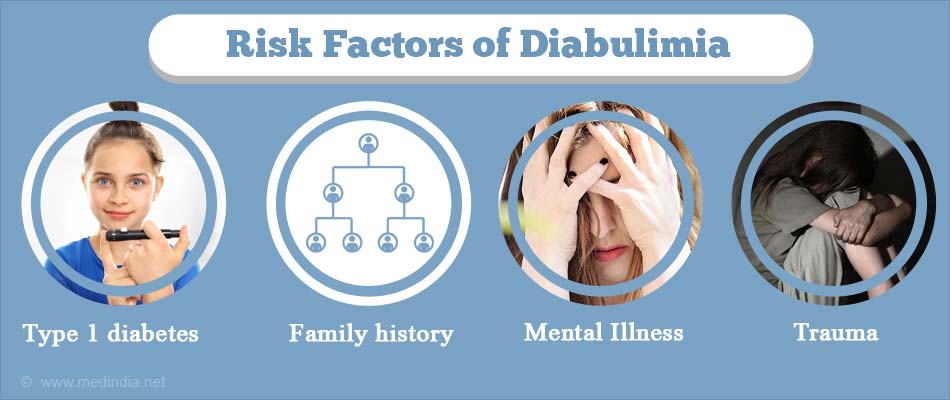- Higher drive for thinness in adolescent males with insulin‐dependent diabetes mellitus compared with healthy controls. Svensson, M., Engström, I., & Åman, J. 2003. Acta Paediatrica, 92(1), 114- 117.
- Psychosocial aspects of diabetes management: dilemma of diabetes distress. Tareen RS1, Tareen K2. Transl Pediatr. 2017 Oct; 6(4):383-396.
- Diabulimia: what it is and how to recognize it in critical care. Ruth-Sahd LA1, Schneider M, Haagen B Dimens Crit Care Nurs. 2009 Jul-Aug;28(4):147-53
- Eating disorders today-not just a girl thing. Hepworth K. 2010 Jul-Sep;27(3):236-41
- Diabulimia, a Type I diabetes mellitus-specific eating disorder. Kınık MF1, Gönüllü FV1, Vatansever Z1, Karakaya ITurk Pediatri Ars. 2017 Mar 1; 52 (1):46-49.
- Intentional hypoglycemia to control bingeing in a patient with type 1 diabetes and bulimia nervosa. Moosavi M, Kreisman S, Hall L Can J Diabetes. 2015 Feb; 39 (1):16-7.
- Diabulimia: how eating disorders can affect adolescents with diabetes. Davidson J. Nurs Stand. 2014 Sep 16; 29 (2):44-9
What is Diabulimia?
Diabulimia is a word that combines the meaning of two words - diabetes and bulimia. Diabetes is a condition characterized by improper storage and use of glucose due to insufficient amounts of insulin and bulimia is an eating disorder where the patient eats excessively and then induces vomiting to bring out the food. Diabulimia also known as ED-DMT1 (Eating Disorder-Diabetes Mellitus Type 1) is one of the most dangerous eating disorders and refers to the unhealthy practice of stopping or reducing insulin to manipulate or lose weight.
Diabulimia is still not recognized as a medical condition but it seems to be very well-known among diabetics. The individuals who are diagnosed with diabetes during adolescence, withhold the diet management and insulin treatment for body appearance and social acceptance issues leading to this disorder.
What are the Causes of Diabulimia?
Diabulimia is caused when an individual with diabetes reduces or completely stops the intake of insulin they require just as a way of losing weight. This way of weight reduction is extremely dangerous for one’s health because it causes the blood sugar levels to increase, causing an extra burden for the kidneys by making them work harder in an effort to remove excess glucose from the body through urination.
Individuals suffering from diabulimia intentionally misuse insulin for weight control by the following ways:
- Reduction in the prescribed dose of insulin
- Stop the intake of insulin
- Delay in appropriate dose
- Manipulation of insulin

What are the Symptoms and Signs of Diabulimia?
Diabulimia patients maintain secrecy about their blood sugar levels, insulin shots, eating habits, and their blood sugar records do not match hemoglobin A1C results. They are generally preoccupied with their body image and have a tendency to cancel doctors' appointments.
Symptoms of diabulimia can be divided into short term, medium term and long term symptoms.
Short term: These are the short term symptoms of patients with diabulimia:
- High blood glucose levels (Above 600 mg/dL or higher on a continuous basis)
- Weakness
- Fatigue
- Large amounts of glucose in the urine
- Constant urination
- Constant thirst
- Excessive appetite
- Inability to concentrate
- Electrolyte disturbance
- Severe ketonuria and ketonemia
- Low sodium/potassium levels
Medium term symptoms: These symptoms are shown when diabulimia is left untreated and so also includes some of the symptoms:
- Moderate to excessive dehydration
- Indigestion
- Muscle atrophy
- GERD- Gastroesophageal reflux disease
- High cholesterol
- Severe weight loss
- Edema with fluid replacement
- Proteinuria
Long term symptoms: If a type I diabetic person undergoes alternating phases of diabulimia, then the following long term symptoms will be expected:
- High cholesterol
- Extreme fatigue
- Osteoporosis
- Retinopathy
- Repeated bladder and yeast infections
- Edema
- Neuropathy
- Nephropathy eventually leading to kidney failure
- Heart problems
- Death

What are the Risks Factors of Diabulimia?
Diabulimia is due to a combination of biological, psychological and sociocultural factors.
Following are the risk factors of diabulimia:
Type 1 Diabetes: Approximately 25% of women diagnosed with type 1 diabetes develop an eating disorder.
Family history: Recent studies have shown that if one has relatives (first degree relatives) with eating disorders or other mental illness like anxiety, depression, or addiction, it increases an individual’s risk for developing an eating disorder.
Gender: A person of any gender can develop diabulimia but females have higher rates of developing the condition.
Athletes: Individuals who actively participate in sports such as dance, running and gymnastics prefer slim bodies and so they skip the treatment and may end up getting diabulimia.
Homosexuals: Individuals who are identified as non-heterosexual or not cis-gender have higher risks of getting diabulimia due to discrimination and body image distress.
Yo-yo dieting: It is also known as weight cycling as it leads to weight loss followed by weight gain; as a result this dieting practice can sometimes lead to eating disorders such as diabulimia.
Mental illness: Anxiety, depression, obsessive compulsive disorder, and other mental illnesses often are associated with diabulimia and anorexia.
Trauma: Sometimes events such as violence, abuse, injury, loss of a loved one and other distressing situations can lead to the development of an eating disorder as a coping strategy.

How do you Diagnose Diabulimia?
If a diabetic individual has hyperglycemia, elevated HbA1c even with insulin treatment, weight loss in spite of increased food intake, recurrent diabetic ketoacidosis, and characteristic symptoms of diabetes such as excessive hunger, urination and thirst, then it is diagnosed as diabulimia.
Most of the diabulimia patients go undiagnosed for many years as they simply fool their endocrinologists or diabetes educators.
Health care providers should check the HbA1c levels, as a measure of average blood glucose in diabetic individuals who are taking insulin treatment and if the levels do not match up with what the patient is saying about their use of insulin that may indicate an eating disorder. In some cases, if the HbA1c is high and the patient says he or she is taking insulin (even if she is not taking), the doctor may assume that the patient needs more insulin but an experienced doctor will diagnose it as diabulimia.
How do you Treat Diabulimia?
As such there is no specific treatment for diabulimia but its treatment requires a comprehensive treatment team including a diabetes educator, an endocrinologist, a dietitian, an eating disorder specialist, and a psychotherapist. As diabulimia involves both diabetes and bulimia, it is better to have a team which can understand both the problems. The best treatment is the residential one at a facility that specializes in both diabetes and eating disorders. Some of the therapies which can be used to treat diabulimia are:
- Cognitive behavior therapy - a therapy where the psychologist will make the person talk about their problems and make them overcome them by thinking and behaving differently
- Dialectical behavior therapy - it is based on cognitive behavioral therapy but there is a lot of emphasis placed on the relationship between the therapist and the affected person which is used to motivate the person to change
- Education about healthy eating behavior
- Yoga and meditation provide the opportunity for patients to integrate mental, physical and spiritual aspects of themselves supporting their confidence, self-esteem, and giving a deeper connection to their authentic feelings rather than giving importance to body images.

How do you Prevent Diabulimia?
- Diabulimia is still a comparatively unknown medical condition, so raising an awareness about this disorder is necessary for prevention and better management.
- Development of targeted treatment programs focusing on optimal diabetes management.
- People should be educated to determine their body mass index to understand healthy weight.
- As diabulimia is a disorder which is frequently observed in teenagers, all school health personnel should work together to accommodate students with diabulimia and improve their knowledge about the importance of healthy diet and exercise to prevent disease.
- We need to educate them and address the issues in a non embarassing way.
- If you suspect someone to be suffering from symptoms of diabulimia, bring it to the attention and contact a diabetes healthcare team to receive support. An early diagnosis and intervention can make a lot of difference.
- As diabulimia is also associated with fear, anxiety, depression and other mental illness, yoga and meditation can be a good option to prevent the onset of diabulimia in diabetic patients.











